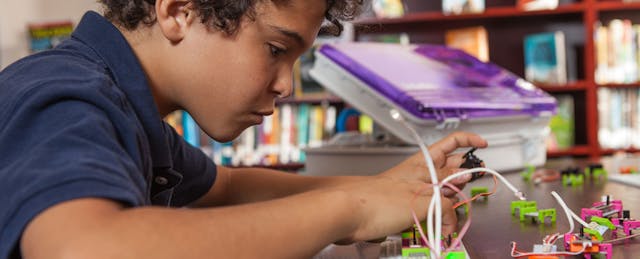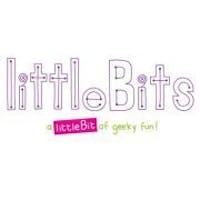I will preface this by saying that I am not an educator. I am an engineer, an artist and an entrepreneur who is very passionate about 21st-century learning.
I started littleBits from a very personal place. I grew up in Beirut and did my undergrad in engineering. I actually wanted to be a designer, but my parents and teachers said I owed it to myself to be an engineer. One of the first assignments we had was to learn the Z80 processor.
The Z80 is one of the most influential and cloned processors ever, but by the time we encountered it, the Z80 processor was already obsolete. I really didn’t enjoy the learning experience; it was dry, boring, and had little relevance to my daily life. I wanted to quit engineering.
On the other hand, I also had a father who gave me construction kits, chemistry sets, and software to make greeting cards. I spent my childhood tinkering and making and breaking. My unrelenting desire to try new tools had me bending things in ways they weren’t meant to be bent. I broke open VCRs and rigged my bedroom door to sound an alarm when my sisters opened it. I even hacked some greeting card software so I could make large banners on a dot matrix printer, wishing my mom, “Welcome home from work.” Clearly I had passion for creating and inventing. But my education didn’t leverage my interests. Instead, it discouraged them.
Looking back, I realize that my “dry and boring” experience with the Z80 taught me how to think. Overall, my traditional education had a lot of rigor and depth. We weren’t jumping around between topics, but instead were detail-oriented and thoughtful. As a result, I learned to analyze, problem solve and deal with complexity -- essential skills for an engineer and, as it turns out, an entrepreneur.
After studying engineering for four years, I discovered the Media Lab at MIT, and was introduced to the maker movement. My class with Neil Gershenfeld, “How to Make Almost Anything,” was featured in the very first issue of MAKE magazine. That semester marked my true initiation into constructionism and the maker movement. Gershenfeld’s class was a very different educational experience from any I’d had before. It was completely rooted in project-based learning; we learned by doing and immersing ourselves in hands-on problems, adopting new tools and techniques as we sought new information. We felt unbounded, creative, invigorated--and challenged.
A few years later, I started littleBits, a platform of electronic building blocks to create inventions, large and small. Our educational mission is to empower people everywhere to understand and reinvent their world. Currently, littleBits is used by 9,200 educators in 2,200 schools, 400 universities, and 240 libraries and makerspaces across 60 countries.
Finding Common Ground
Over the past eight years, I have seen a rift between the maker movement and “real education.” I’ve sat in on meetings with after-school teachers who have seen maker tools and project-based learning do wonders for their students’ engagement, curiosity and real-world skills. But as soon as I ask them why they don’t use maker techniques during regular class time, they draw a very firm line, citing the necessity of teaching to “standards.” These same standards, however, are often bemoaned by maker movement advocates, who feel that our current schools are broken.
I would argue that this is not an issue that should be polarized. To build a complex system of world-changing technology, you need both the maker’s creativity and the rigor of standards (whether we have the right standards in place is for another discussion). At its heart, the standards movement is about rigor, depth and equality, in hopes of ensuring that students everywhere have the same strong foundation. The maker movement opens up new and more creative ways of thinking and reframing problems.
Those in the standards “camp” must remember the power of experimentation, play, invention and self-directed learning in classrooms. Students need to be able to deeply understand not only what is in front of them, but also to imagine and create what could be. They need to be able to “fail forward” to do this, embracing mistakes and marveling at what they create after trial and error. We need bridge-builders whose structures reflect the best engineering practices but who also dare to create new kinds of bridges for landscapes and climate scenarios we haven’t thought of yet. In fact, just recently engineers tested origami-inspired bridges for disaster relief areas; these kinds of innovative solutions depend on being able to think creatively and flexibly beyond what exists today.
Along the same lines, it’s time for maker ed to move into the mainstream. Making should not be relegated to the times spent outside of class, e.g. lunch or after school. Nor should it only flourish in private schools, which don’t have to teach to standards. We need to work to show how making is a rigorous process that leads to valuable new technologies, products and experiences. Specifically, we need to tie maker projects to standards-based curriculum and show clearly the kinds of knowledge, skills and practices students learn as part of making. At littleBits, we have deliberately begun to align our library of lessons to standards and build educator resources that reflect the daily realities of classrooms.
Earlier this year, Edutopia’s Betty Ray shared examples of districts and schools that are starting to integrate maker ed into the regular curriculum. After units on the Civil Rights movement, including the Americans with Disabilities Act, and another unit about inventors, one fifth grade class used littleBits to explore how they might improve the lives of people living with disabilities. Other teachers have used littleBits to teach lessons about grammar, measuring the atmosphere, and probability.
I would not be where I am today were it not for both the high academic standards to which my parents and teachers held me and the freedom and power I felt when tinkering, making and imagining new inventions. To be ready for careers, technologies, problems and opportunities of the future, we need our children to be able to imagine a new world and also have the knowledge to build it with strength and precision. We must give them the tools to do both.



